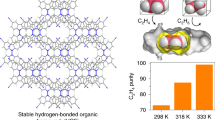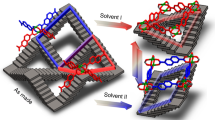Abstract
Supramolecular interactions are fundamental to host–guest binding in many chemical and biological processes. Direct visualization of such supramolecular interactions within host–guest systems is extremely challenging, but crucial to understanding their function. We report a comprehensive study that combines neutron scattering, synchrotron X-ray and neutron diffraction, and computational modelling to define the detailed binding at a molecular level of acetylene, ethylene and ethane within the porous host NOTT-300. This study reveals simultaneous and cooperative hydrogen-bonding, π···π stacking interactions and intermolecular dipole interactions in the binding of acetylene and ethylene to give up to 12 individual weak supramolecular interactions aligned within the host to form an optimal geometry for the selective binding of hydrocarbons. We also report the cooperative binding of a mixture of acetylene and ethylene within the porous host, together with the corresponding breakthrough experiments and analysis of adsorption isotherms of gas mixtures.
This is a preview of subscription content, access via your institution
Access options
Subscribe to this journal
Receive 12 print issues and online access
$259.00 per year
only $21.58 per issue
Buy this article
- Purchase on Springer Link
- Instant access to full article PDF
Prices may be subject to local taxes which are calculated during checkout





Similar content being viewed by others
References
Vaidhyanathan, R. et al. Direct observation and quantification of CO2 binding within an amine-functionalized nanoporous solid. Science 330, 650–653 (2010).
Rabone, J. et al. An adaptable peptide-based porous material. Science 329, 1053–1057 (2010).
Long, J. R. & Yaghi, O. M. The pervasive chemistry of metal–organic frameworks. Chem. Soc. Rev. 38, 1201–1507 (2009).
Zhou, H. C., Long, J. R. & Yaghi, O. M. Introduction to metal–organic frameworks. Chem. Rev. 112, 673 (2012).
Davis, M. E. Ordered porous materials for emerging applications. Nature 417, 813–821 (2002).
Yang, S. et al. A partially interpenetrated metal–organic framework for selective hysteretic sorption of carbon dioxide. Nature Mater. 11, 710–716 (2012).
Yan, Y. et al. Metal–organic polyhedral frameworks: high H2 adsorption capacities and neutron powder diffraction studies. J. Am. Chem. Soc. 132, 4092–4094 (2010).
Lin, X. et al. High capacity hydrogen adsorption in Cu(II) tetracarboxylate framework materials: the role of pore size, ligand functionalization, and exposed metal sites. J. Am. Chem. Soc. 131, 2159–2171 (2009).
Geier, S. J. et al. Selective adsorption of ethylene over ethane and propylene over propane in the metal–organic frameworks M2(dobdc) (M = Mg, Mn, Fe, Co, Ni, Zn). Chem. Sci. 4, 2054–2061 (2013).
Bloch, E. D. et al. Hydrocarbon separations in a metal–organic framework with open iron(II) coordination sites. Science 335, 1606–1610 (2012).
Matsuda, R. et al. Highly controlled acetylene accommodation in a metal–organic microporous material. Nature 436, 238–241 (2005).
Zhang, J. & Chen, X. Optimized acetylene/carbon dioxide sorption in a dynamic porous crystal. J. Am. Chem. Soc. 131, 5516–5521 (2009).
Rowsell, J. L. C., Spencer, E. C., Eckert, J., Howard, J. A. K. & Yaghi, O. M. Gas adsorption sites in a large-pore metal–organic framework. Science 309, 1350–1354 (2005).
Spencer, E. C., Howard, J. A. K., McIntyre, G. J., Rowsell, J. L. C. & Yaghi, O. M. Determination of the hydrogen absorption sites in Zn4O(1,4-benzenedicarboxylate) by single crystal neutron diffraction. Chem. Commun. 278–280 (2006).
Yang, S. et al. Selectivity and direct visualization of carbon dioxide and sulfur dioxide in a decorated porous host. Nature Chem. 4, 887–894 (2012).
He, Y., Xiang, S. & Chen, B. A microporous hydrogen-bonded organic framework for highly selective C2H2/C2H4 separation at ambient temperature. J. Am. Chem. Soc. 133, 14570–14573 (2011).
Xiang, S-C. et al. Rationally tuned micropores within enantiopure metal–organic frameworks for highly selective separation of acetylene and ethylene. Nature Commun. 2, 204 (2011).
Li, B. et al. Introduction of π-complexation into porous aromatic framework for highly selective adsorption of ethylene over ethane. J. Am. Chem. Soc. 136, 8654–8660 (2014).
Myers, A. L. & Prausnitz, J. M. Thermodynamics of mixed-gas adsorption. AlChE J. 11, 121–127 (1965).
He, Y., Krishna, R. & Chen, B. Metal–organic frameworks with potential for energy-efficient adsorptive separation of light hydrocarbons. Energy Environ. Sci. 5, 9107–9120 (2012).
Anson, A., Wang, Y., Lin, C. C. H., Kuznicki, T. M. & Kuznicki, S. M. Adsorption of ethane and ethylene on modified ETS-10. Chem. Eng. Sci. 63, 4171–4175 (2008).
Bae, Y-S. et al. High propene/propane selectivity in isostructural metal–organic frameworks with high densities of open metal sites. Angew. Chem. Int. Ed. 51, 1857–1860 (2012).
Peralta, D. et al. Comparison of the behavior of metal−organic frameworks and zeolites for hydrocarbon separations. J. Am. Chem. Soc. 134, 8115–8126 (2012).
Ramirez-Cuesta, A. J. aCLIMAX 4.0.1, the new version of the software for analyzing and interpreting INS spectra. Comput. Phys. Commun. 157, 226–238 (2004).
Clark, S. J. et al. First principles methods using CASTEP. Z. Kristall. 220, 567–570 (2005).
Refson, K., Tulip, P. R. & Clark, S. J. Variational density-functional perturbation theory for dielectrics and lattice dynamics. Phys. Rev. B 73, 155114 (2006).
Boscoboinik, J. A. et al. Interaction of probe molecules with bridging hydroxyls of two-dimensional zeolites: a surface science approach. J. Phys. Chem. C 117, 13547–13556 (2013).
Jobic, H. & Theodorou, D. N. Quasi-elastic neutron scattering and molecular dynamics simulation as complementary techniques for studying diffusion in zeolites. Micropor. Mesopor. Mater. 102, 21–50 (2007).
Rives, S. et al. Diffusion of xylene isomers in the MIL-47(V) MOF material: a synergic combination of computational and experimental tools. J. Phys. Chem. C 117, 6293–6302 (2013).
Salles, F. et al. Diffusion of binary CO2/CH4 mixtures in the MIL-47(V) and MIL-53(Cr) metal–organic framework type solids: a combination of neutron scattering measurements and molecular dynamics simulations. J. Phys. Chem. C 117, 11275–11284 (2013).
Acknowledgements
S.Y. acknowledges receipt of a Nottingham Research Fellowship and a Leverhulme Trust Early Career Research Fellowship, and M.S. the receipt of a European Research Council Advanced Grant and an Engineering and Physical Sciences Research Council Programme Grant. We are especially grateful to STFC and the ISIS Neutron Facility for access to Beamlines TOSCA, WISH, IRIS and the SCARF supercomputer resources, and to Diamond Light Source for access to Beamline I11. We thank C. Goodway and M. Kibble of the user support group at ISIS and J. Potter at Diamond for the technical help with the beamlines. We also thank J. Ke for helpful discussions on the implementation of IAST. This research used resources of the Oak Ridge Leadership Computing Facility at the Oak Ridge National Laboratory, which is supported by the Office of Science of the US Department of Energy under Contract No. DE-AC05-00OR22725.
Author information
Authors and Affiliations
Contributions
S.Y. and R.N. carried out syntheses, characterization of MOF samples, measurements and analysis of adsorption isotherms. S.Y., S.K.C. and C.C.T. collected and analysed the synchrotron X-ray powder diffraction data. S.Y., A.J.R-C., R.N., V.G-S., P.M., S.K.C. and S.I.C. carried out the collection, analysis, refinement and DFT modelling of neutron-scattering data. S.Y. and M.S. provided the overall direction and supervision of the project and prepared the manuscript.
Corresponding authors
Ethics declarations
Competing interests
The authors declare no competing financial interests.
Supplementary information
Supplementary information
Supplementary information (PDF 17989 kb)
Supplementary information
Crystallographic data for compound NOTT-300·4C2H2. (CIF 1 kb)
Supplementary information
Crystallographic data for compound NOTT-300·2.5C2H4. (CIF 2 kb)
Supplementary information
Crystallographic data for compound NOTT-300·2.7C2D2. (CIF 2 kb)
Supplementary information
Crystallographic data for compound NOTT-300·1.8C2D4. (CIF 2 kb)
Supplementary information
Crystallographic data for compound NOTT-300·1.3C2D6. (CIF 2 kb)
Rights and permissions
About this article
Cite this article
Yang, S., Ramirez-Cuesta, A., Newby, R. et al. Supramolecular binding and separation of hydrocarbons within a functionalized porous metal–organic framework. Nature Chem 7, 121–129 (2015). https://doi.org/10.1038/nchem.2114
Received:
Accepted:
Published:
Issue Date:
DOI: https://doi.org/10.1038/nchem.2114



